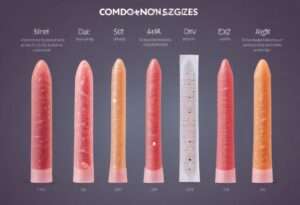Understanding Condom Sizes: A Comprehensive Guide to Choosing the Right Fit
When it comes to safe and enjoyable sex, finding the right condom size is crucial. Many people don’t realize that condoms come in various sizes, and using the wrong size can lead to discomfort, reduced effectiveness, or even condom failure. In this comprehensive guide, we’ll explore everything you need to know about condom sizes, how to measure yourself, and how to choose the perfect fit for maximum protection and pleasure.
Condoms and STDs: Understanding Protection and Limitations

Table of Contents
ToggleWhy Condom Size Matters
Before we dive into the specifics of condom sizes, it’s important to understand why finding the right fit is so crucial:
1. Effectiveness: A properly fitting condom is more likely to stay in place during sex, reducing the risk of slippage or breakage. This ensures maximum protection against sexually transmitted infections (STIs) and unintended pregnancy.
2. Comfort: Wearing a condom that’s too tight or too loose can be uncomfortable, potentially leading to reduced sensation or even pain during intercourse.
3. Pleasure: A well-fitting condom allows for better sensation and can enhance the overall sexual experience for both partners.
4. Confidence: Knowing you’re using the right size condom can boost your confidence and allow you to focus on enjoying the moment rather than worrying about protection.
Giardiasis: Understanding, Preventing and Treating the “Beaver Fever”
Understanding Condom Measurements
Condoms are typically measured in three key dimensions:
1. Length: The distance from the tip to the base of the condom when fully unrolled.
2. Width: The measurement across the condom when laid flat (also known as nominal width).
3. Thickness: The thickness of the condom material, which can affect sensitivity and durability.
It’s important to note that condom sizes can vary between manufacturers, so always check the specific measurements provided by the brand you’re considering.
Pubic Lice (Crabs): Symptoms, Diagnosis and Treatment
How to Measure Your Penis for Condom Sizing?
To find the right condom size, you’ll need to measure your penis. Here’s how to do it accurately:
1. Length: Measure from the base of your penis to the tip when fully erect.
2. Girth: Measure the circumference of your penis at its widest point when erect. To get the width (nominal width), divide this number by 2.25.
Remember, it’s normal for measurements to vary slightly from day to day, so take multiple measurements and use the average for the most accurate results.
Is Scabies an STD? Understanding the Facts About This Contagious Skin Condition

Condom Size Categories
Condoms generally fall into three main size categories:
1. Standard/Regular: These fit the majority of men and typically range from 7-7.8 inches (178-198 mm) in length and 1.9-2.1 inches (48-53 mm) in nominal width.
2. Snug/Slim: Designed for men with a slimmer girth, these condoms usually have a nominal width of 1.7-1.9 inches (43-48 mm).
3. Large/XL: For men with above-average girth, these condoms typically have a nominal width of 2.1-2.5 inches (53-64 mm) or more.
Condom Size Chart
Here’s a general guide to help you choose the right condom size based on your measurements:
Penis Girth (inches) | Recommended Condom Size |
Less than 4.7 | Snug/Slim |
4.7 – 5.1 | Standard/Regular |
4.7 – 5.1 | Large/XL |
Over 6.0 | Extra Large/XXL |
Note: This chart is a general guide. Always refer to specific brand measurements for the most accurate sizing.
How Long Does It Take for Chlamydia to Show Up? Understanding the Timeline and Symptoms
Factors Affecting Condom Fit
While size is crucial, other factors can influence how a condom fits and feels:
1. Shape: Some condoms are designed with a flared or contoured shape to provide a more natural fit.
2. Material: Latex, polyurethane, and polyisoprene condoms may fit differently due to their unique properties.
3. Lubricant: The amount and type of lubricant used can affect how the condom feels and stays in place.
4. Temperature: Extreme temperatures can affect condom elasticity, so always store condoms in a cool, dry place.
Common Condom Sizing Issues and Solutions
Even with proper measurements, you might encounter some sizing issues. Here are some common problems and how to address them:
1. Condom too tight:
– Try a larger size or a brand with more stretch.
– Look for condoms labeled as “extra headroom” or with a flared shape.
Trichomoniasis: Understanding, Preventing and Treating this Common STI
2. Condom too loose:
– Try a snugger fit or consider using a condom size smaller.
– Explore brands that offer slim or snug options.
3. Condom rolls up during use:
– This often indicates the condom is too big. Try a smaller size or a snugger fit.
4. Condom breaks frequently:
– If you’re using the correct size, try a thicker condom or one made from a stronger material.
– Ensure you’re using enough lubricant to reduce friction.
5. Loss of sensation:
– Experiment with ultra-thin condoms or those designed for increased sensitivity.
– Make sure you’re not using a condom that’s too large, as this can reduce sensation.
Tips for Finding Your Perfect Fit
1. Try sample packs: Many brands offer variety packs with different sizes and styles. This can be a cost-effective way to find your ideal fit.
2. Don’t assume one size fits all: Just because a condom is labeled “one size fits all” doesn’t mean it’s the best option for you.
3. Consider both length and width: A condom that’s long enough but too tight (or vice versa) won’t provide optimal comfort or protection.
4. Check for regional differences: Condom sizes can vary between countries, so be aware of this when traveling or purchasing from international sellers.
5. Don’t be embarrassed: Remember, using the right size condom is about health and safety. Sex shop staff and healthcare providers are accustomed to discussing these topics and can offer valuable advice.
The Importance of Proper Condom Use
While finding the right size is crucial, proper condom use is equally important for effectiveness:
1. Check the expiration date before use.
2. Store condoms in a cool, dry place away from direct sunlight.
3. Open the package carefully to avoid damaging the condom.
4. Place the condom on the erect penis before any genital contact occurs.
5. Leave space at the tip for ejaculate.
6. Roll the condom down to the base of the penis.
7. After ejaculation, hold the base of the condom while withdrawing to prevent slippage.
8. Dispose of the used condom properly in the trash, not in the toilet.
For a detailed guide on proper condom use, visit the Centers for Disease Control and Prevention’s condom use page: https://www.cdc.gov/condomeffectiveness/male-condom-use.html
Conclusion
Finding the right condom size is an essential part of safe and enjoyable sex. By taking accurate measurements, understanding sizing options, and being willing to experiment with different brands and styles, you can find the perfect fit for your needs. Remember, a well-fitting condom not only provides better protection but can also enhance pleasure for both partners.
Don’t hesitate to consult with healthcare providers or sexual health clinics if you have any concerns or questions about condom sizing or use. Your sexual health and satisfaction are important, and finding the right condom is a key part of that journey.
Reference to External Sources Used:
1. Centers for Disease Control and Prevention: https://www.cdc.gov/condomeffectiveness/male-condom-use.html
2. World Health Organization – Condom Quality Assurance: https://www.who.int/teams/sexual-and-reproductive-health-and-research/areas-of-work/fertility-care/condoms
3. American Sexual Health Association: https://www.ashasexualhealth.org/sexual-health/all-about-condoms/
4. Planned Parenthood – Condom Guide: https://www.plannedparenthood.org/learn/birth-control/condom
5. National Health Service (NHS) UK – Condoms: https://www.nhs.uk/conditions/contraception/male-condoms/


